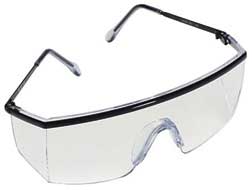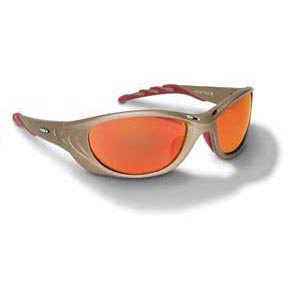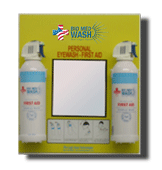 Wear your safety glasses. It’s a simple rule, and one that workers obey more than ever thanks to awareness campaigns, enforcement and the wide array of technologically advanced, funky-looking protective eyewear on the market today. Yet many Canadian eyes remain unprotected, with injuries occurring at an alarming rate. A recent study found that 60 per cent of workplace eye injuries result from not wearing eye protection.
Wear your safety glasses. It’s a simple rule, and one that workers obey more than ever thanks to awareness campaigns, enforcement and the wide array of technologically advanced, funky-looking protective eyewear on the market today. Yet many Canadian eyes remain unprotected, with injuries occurring at an alarming rate. A recent study found that 60 per cent of workplace eye injuries result from not wearing eye protection.COS asked Gerry Culina, manager of general health and safety services at the Canadian Centre for Occupational Health and Safety (CCOHS), about some of the common errors or deficiencies in the workplace that can lead to eye injuries. Here’s what he says can go wrong:Not knowing the hazards — It’s important to conduct a needs assessment, since whether or not you need eye protection (and what kind) depends on the work, the work environment and the hazards in the workplace. The process can involve, for example, a workplace survey that asks what types of accidents have taken place, what hazards people are reporting, whether the Ministry of Labour has ever issued an order, and whether someone has had an eye injury in the last few years. Inspect, audit, interview — do whatever is necessary to fully understand the hazards of everyone’s job.
 Using PPE as a safety shortcut — The way to address a workplace hazard, according to virtually every safety authority in the world, is to eliminate the hazard at the source, eliminate the hazard along the path, and as a last resort, eliminate it at the worker. That means before relying on protective eyewear, it’s much safer to eliminate the hazard altogether or, if that’s not possible, along the path via labeling, administration controls, automating dangerous tasks, and/or keeping workers at a distance from the hazard. “The farther away, or least amount of time we can expose a person to a chemical or particulates, the less chance of injury,” Culina says. He adds that PPE is a short-term method that shouldn’t be considered a long-term solution.
Using PPE as a safety shortcut — The way to address a workplace hazard, according to virtually every safety authority in the world, is to eliminate the hazard at the source, eliminate the hazard along the path, and as a last resort, eliminate it at the worker. That means before relying on protective eyewear, it’s much safer to eliminate the hazard altogether or, if that’s not possible, along the path via labeling, administration controls, automating dangerous tasks, and/or keeping workers at a distance from the hazard. “The farther away, or least amount of time we can expose a person to a chemical or particulates, the less chance of injury,” Culina says. He adds that PPE is a short-term method that shouldn’t be considered a long-term solution.
Improper fit — The chances of safety eyewear fitting the wearer are greater now that manufacturers offer them in various shapes and sizes, a vast improvement over the one-size-fits-all era of the past. When selecting eyewear, make sure it is form fitting to protect the eyes from particulates and liquids getting in.
Inappropriate lenses for the circumstances — The term “safety eyewear” can mean many things, so know what yours is meant to protect you from. If it keeps out harmful chemicals it might not necessarily protect you from a high-speed projectile. If it’s practically bulletproof it might not necessarily be designed to keep out small, airborne particulates. Find out all you can about exactly what features you need in your protective eyewear. Watch out for tinted lenses. There are right and wrong applications for tinted lenses. They might actually be mandated for outdoor workers, as long as they have the appropriate UV protection rating. Some workplaces, however, forbid the use of tinted lenses, Culina says, because it’s hard to see out of them once you enter an indoor hazardous environment.
Not safety approved — Beware of products that call themselves “safety glasses”. Make sure they fit the standards referenced in your occupational health and safety legislation.
Wear glasses when glasses aren’t enough — Some work environments call for mono goggles or a face shield for maximum protection, or both safety glasses and a face shield. You wouldn’t want dangerous chemicals, for instance, to get inside your glasses and drip anywhere near your eyes. A workplace hazard assessment should clearly indicate what level of protection is needed.
The wrong lens for the environmental conditions — Some lens materials are made to withstand hot or cold environments. Get the right one to avoid the kind of compromised vision that happens when glasses steam up in a steel mill or frost up in sub-zero weather.
Wearing eyewear somewhere else (other than over the eyes!) — “Wearing safety glasses” doesn’t mean wearing them on your head or around your neck. Eye safety glasses are for your eyes only.
 Not wanting to trouble the employer for yet another replacement pair — Protective eyewear should be replaced if scratched, damaged or broken. Unfortunately what often happens, Culina says, is that workers who need prescription safety eyewear, especially bifocals or trifocals, tend to hang onto scratched, damaged ones longer because they’re so costly to the employer. The solution: Wear your regular glasses and wear mono goggles over top.
Not wanting to trouble the employer for yet another replacement pair — Protective eyewear should be replaced if scratched, damaged or broken. Unfortunately what often happens, Culina says, is that workers who need prescription safety eyewear, especially bifocals or trifocals, tend to hang onto scratched, damaged ones longer because they’re so costly to the employer. The solution: Wear your regular glasses and wear mono goggles over top.
No access to an eyewash station — Again, your workplace hazard assessment should identify whether an eyewash station is needed, what type, and where it should be located. Currently there is no Canadian standard for the design or placement of eyewash standards for emergencies, but there is an American standard, ANSI Z358.1.
The water should be just the right temperature so that the affected worker will be abe to tolerate the recommended minimum 15-minute eye rinse. Some eyewash stations contain a saline solution that’s self-contained, eliminating concerns for water that’s too hot or cold.
Source: Canadian Occupational Safety
Discussion
No comments yet.